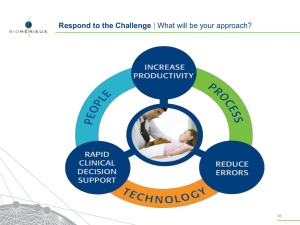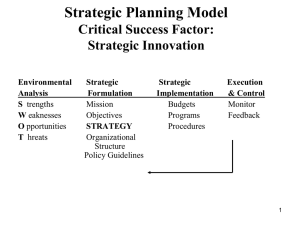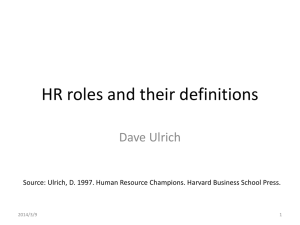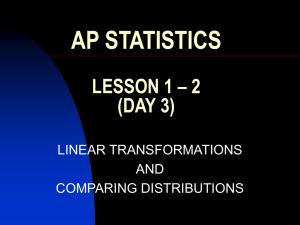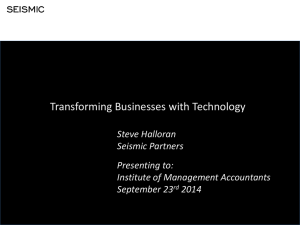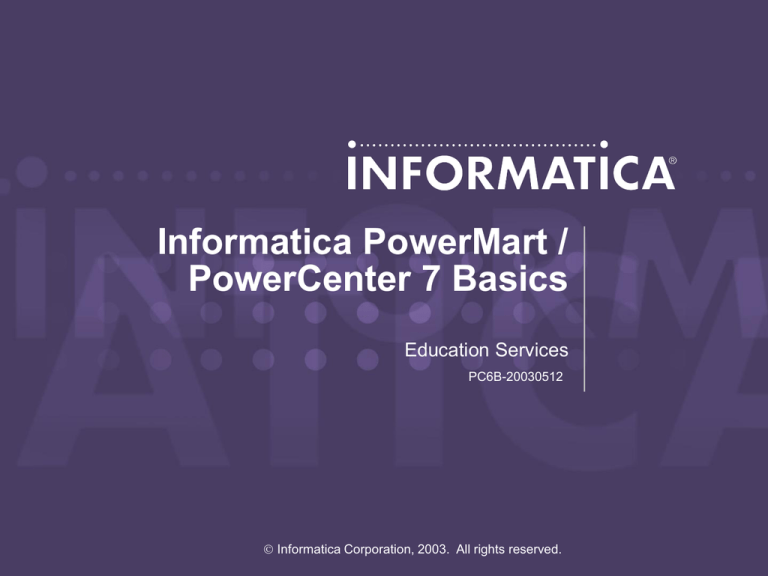
Informatica PowerMart /
PowerCenter 7 Basics
Education Services
PC6B-20030512
Informatica Corporation, 2003. All rights reserved.
Course Objectives
At the end of this course you will:
Understand how to use all major PowerCenter 7
components
Be able to perform basic Repository administration tasks
Be able to build basic ETL Mappings and Mapplets
Be able to create, run and monitor Workflows
Understand available options for loading target data
Be able to troubleshoot most problems
2
Extract, Transform, and Load
Operational Systems
RDBMS Mainframe
Decision Support
Data
Warehouse
Other
Aggregate Data
• Transaction level data
Cleanse Data
• Optimized for Transaction
Consolidate Data
Response Time
Apply Business Rules
De-normalize
• Current
• Normalized or DeTransform
Normalized data
Extract
ETL
• Aggregated data
• Historical
Load
3
PowerCenter Architecture
4
PowerCenter 7 Architecture
Server
native
native
Targets
Sources
TCP/IP
Heterogeneous
Targets
Repository
Server
TCP/IP
Heterogeneous
Targets
Repository
Agent
native
Repository Designer Workflow Workflow Rep Server
Manager
Manager Monitor Administrative
Console
Not Shown: Client ODBC Connections for Source and Target metadata
Repository
5
PowerCenter 7 Components
PowerCenter Repository
PowerCenter Repository Server
PowerCenter Client
• Designer
• Repository Manager
• Repository Server Administration Console
• Workflow Manager
• Workflow Monitor
PowerCenter Server
External Components
• Sources
• Targets
6
Repository Topics
By the end of this section you will be familiar with:
The purpose of the Repository Server and Agent
The Repository Server Administration Console GUI
interface
The Repository Manager GUI interface
Repository maintenance operations
Security and privileges
Object sharing, searching and locking
Metadata Extensions
7
Repository Server
Each Repository has an independent architecture for the
management of the physical Repository tables
Components: one Repository Server, and a Repository
Agent for each Repository
Server
Repository
Server
Repository
Agent
Repository
Manager
Repository Server
Administration Console
Repository
Client overhead for Repository management is greatly
reduced by the Repository Server
8
Repository Server Features
Manages connections to the Repository from client
applications
Can manage multiple Repositories on different
machines on a network
Uses one Repository Agent process to insert, update
and fetch objects from the Repository database tables,
for each Repository it manages
Maintains object consistency by controlling object
locking
The Repository Server runs on the same system running the Repository Agent
9
Repository Server Administration Console
Use Repository Administration console to Administer Repository Servers and
Repositories through Repository Server. Following tasks can be performed:
Add, Edit and Remove Repository Configurations
Export and Import Repository Configurations
Create a Repository
*Promote a local Repository to a Global Repository
Copy a Repository
Delete a Repository from the Database
Backup and Restore a Repository
Start, Stop, enable and Disable a Repositories
View Repository connections and locks
Close Repository connections.
Upgrade a Repository
10
Repository Server Administration Console
Information
Nodes
HTML View
Console Tree
Hypertext Links to
Repository
Maintenance Tasks
11
Repository Management
Perform all Repository
maintenance tasks through
Repository Server from the
Repository Server Administration
Console
Create the Repository
Configuration
Select Repository Configuration
and perform maintenance tasks:
• Create
• Notify Users
• Delete
• Propagate
• Backup
• Register
• Copy from
• Restore
• Disable
• Un-Register
• Export Connection
• Upgrade
• Make Global
12
Repository Manager
Use Repository manager to navigate through multiple folders
and repositories. Perform following tasks:
Manage the Repository
•
Launch Repository Server Administration Console for this
purpose
Implement Repository Security
• Managing Users and Users Groups
Perform folder functions
• Create, Edit, Copy and Delete folders
View Metadata
• Analyze Source, Target, Mappings and Shortcut
dependencies.
13
Repository Manager Interface
Navigator
Window
Main Window
Dependency Window
Output Window
14
Users, Groups and Repository Privileges
Steps:
Create groups
Create users
Assign users to
groups
Assign privileges to
groups
Assign additional
privileges to users
(optional)
15
Managing Privileges
Check box assignment of privileges
16
Folder Permissions
Assign one user as the
folder owner for first tier
permissions
Select one of the owner’s
groups for second tier
permissions
All users and groups in
the Repository will be
assigned the third tier
permissions
17
Object Locking
Object Locks preserve Repository integrity
Use the Edit menu for Viewing Locks and Unlocking
Objects
18
Object Searching
(Menu- Analyze – Search)
Keyword search
•
Limited to keywords
previously defined in
the Repository
(via Warehouse
Designer)
Search all
•
Filter and search
objects
19
Object Sharing
Reuse existing objects
Enforces consistency
Decreases development time
Share objects by using copies and shortcuts
COPY
SHORTCUT
Copy object to another folder
Link to an object in another folder
Changes to original object not
captured
Duplicates space
Dynamically reflects changes to
original object
Preserves space
Copy from shared or unshared folder
Created from a shared folder
Required security settings for sharing objects:
• Repository Privilege:
• Originating Folder Permission:
• Destination Folder Permissions:
Use Designer
Read
Read/Write
20
Adding Metadata Extensions
Allows developers and partners to extend the metadata
stored in the Repository
Accommodates the following metadata types:
• Vendor-defined - Third-party application vendor-created
metadata lists
• For example, Applications such as Ariba or PowerConnect for
Siebel can add information such as contacts, version, etc.
• User-defined - PowerCenter/PowerMart users can define
and create their own metadata
Must have Administrator Repository or Super User
Repository privileges
21
Sample Metadata Extensions
Sample User Defined
Metadata, e.g. - contact
information, business user
Reusable Metadata Extensions can also be created in the Repository Manager
22
Design Process
1. Create Source definition(s)
2. Create Target definition(s)
3. Create a Mapping
4. Create a Session Task
5. Create a Workflow from Task components
6. Run the Workflow
7. Monitor the Workflow and verify the results
23
Source Object Definitions
By the end of this section you will:
Be familiar with the Designer GUI interface
Be familiar with Source Types
Be able to create Source Definitions
Understand Source Definition properties
Be able to use the Data Preview option
24
Source Analyzer
Designer Tools
Analyzer Window
Navigation
Window
25
Methods of Analyzing Sources
Repository
Import from Database
Import from File
Import from Cobol File
Import from XML file
Create manually
Relational
XML file
Source
Analyzer
Flat file
COBOL file
26
Analyzing Relational Sources
Source Analyzer
Relational Source
ODBC
Table
View
Synonym
DEF
Repository
Server
TCP/IP
Repository
Agent
native
DEF
Repository
27
Analyzing Relational Sources
Editing Source Definition Properties
28
Analyzing Flat File Sources
Source Analyzer
Mapped Drive
NFS Mount
Local Directory
Flat File
DEF
Fixed Width or
Delimited
Repository
Server
TCP/IP
Repository
Agent
native
DEF
Repository
29
Flat File Wizard
Three-step
wizard
Columns can
be renamed
within wizard
Text, Numeric
and Datetime
datatypes are
supported
Wizard
‘guesses’
datatype
30
XML Source Analysis
Source Analyzer
Mapped Drive
NFS Mounting
Local Directory
.DTD File
DEF
DATA
Repository
Server
TCP/IP
Repository
Agent
native
DEF
In addition to the DTD file, an
XML Schema or XML file
can be used as a Source
Definition
Repository
31
Analyzing VSAM Sources
Source Analyzer
Mapped Drive
NFS Mounting
Local Directory
Repository
Server
.CBL File
DEF
DATA
TCP/IP
Repository
Agent
native
DEF
Supported Numeric Storage Options:
COMP, COMP-3, COMP-6
Repository
32
VSAM Source Properties
33
Target Object Definitions
By the end of this section you will:
Be familiar with Target Definition types
Know the supported methods of creating Target
Definitions
Understand individual Target Definition properties
34
Creating Target Definitions
Methods of creating Target Definitions
Import from Database
Import from an XML file
Manual Creation
Automatic Creation
35
Automatic Target Creation
Drag-anddrop a
Source
Definition
into
the
Warehouse
Designer
Workspace
36
Import Definition from Database
Can “Reverse engineer” existing object definitions
from a database system catalog or data dictionary
Warehouse
Designer
Database
ODBC
Repository
Server
DEF
TCP/IP
Table
View
Synonym
Repository
Agent
native
Repository DEF
37
Manual Target Creation
1. Create empty definition
2. Add desired columns
3. Finished target definition
ALT-F can also be used to create a new column
38
Target Definition Properties
39
Target Definition Properties
40
Creating Physical Tables
DEF
DEF
DEF
Execute SQL
via
Designer
LOGICAL
PHYSICAL
Repository target table
definitions
Target database
tables
41
Creating Physical Tables
Create tables that do not already exist in target database
Connect - connect to the target database
Generate SQL file - create DDL in a script file
Edit SQL file - modify DDL script as needed
Execute SQL file - create physical tables in target database
Use Preview Data to verify
the results (right mouse
click on object)
42
Transformation Concepts
By the end of this section you will be familiar with:
Transformation types and views
Transformation calculation error treatment
Null data treatment
Informatica data types
Expression transformation
Expression Editor
Informatica Functions
Expression validation
43
Transformation Types
Informatica PowerCenter 7 provides 23 objects for
data transformation
Aggregator: performs aggregate calculations
Application Source Qualifier: reads Application object sources as ERP
Custom: Calls a procedure in shared library or DLL
Expression: performs row-level calculations
External Procedure (TX): calls compiled code for each row
Filter: drops rows conditionally
Joiner: joins heterogeneous sources
Lookup: looks up values and passes them to other objects
Normalizer: reorganizes records from VSAM, Relational and Flat File
Rank: limits records to the top or bottom of a range
Input: Defines mapplet input rows. Available in Mapplet designer
Output: Defines mapplet output rows. Available in Mapplet designer
44
Transformation Types
Router: splits rows conditionally
Sequence Generator: generates unique ID values
Sorter: sorts data
Source Qualifier: reads data from Flat File and Relational Sources
Stored Procedure: calls a database stored procedure
Transaction Control: Defines Commit and Rollback transactions
Union: Merges data from different databases
Update Strategy: tags rows for insert, update, delete, reject
XML Generator: Reads data from one or more Input ports and
outputs XML through single output port
XML Parser: Reads XML from one or more Input ports and outputs
data through single output port
XML Source Qualifier: reads XML data
45
Transformation Views
A transformation has
three views:
Iconized - shows the
transformation in
relation to the rest of
the mapping
Normal - shows the
flow of data through
the transformation
Edit - shows
transformation ports
and properties; allows
editing
46
Edit Mode
Allows users with folder “write” permissions to change
or create transformation ports and properties
Define port level handling
Define transformation
level properties
Enter comments
Make reusable
Switch
between
transformations
47
Expression Transformation
Perform calculations using non-aggregate functions
(row level)
Passive Transformation
Connected
Ports
• Mixed
• Variables allowed
Create expression in an
output or variable port
Click here to invoke the
Expression Editor
Usage
• Perform majority of
data manipulation
48
Expression Editor
An expression formula is a calculation or conditional statement
Used in Expression, Aggregator, Rank, Filter, Router, Update Strategy
Performs calculation based on ports, functions, operators, variables,
literals, constants and return values from other transformations
49
Informatica Functions - Samples
ASCII
CHR
CHRCODE
CONCAT
INITCAP
INSTR
LENGTH
LOWER
LPAD
LTRIM
RPAD
RTRIM
SUBSTR
UPPER
REPLACESTR
REPLACECHR
Character Functions
Used to manipulate character data
CHRCODE returns the numeric value
(ASCII or Unicode) of the first character
of the string passed to this function
For backwards compatibility only - use || instead
50
Informatica Functions
TO_CHAR (numeric)
TO_DATE
TO_DECIMAL
TO_FLOAT
TO_INTEGER
TO_NUMBER
ADD_TO_DATE
DATE_COMPARE
DATE_DIFF
GET_DATE_PART
LAST_DAY
ROUND (date)
SET_DATE_PART
TO_CHAR (date)
TRUNC (date)
Conversion Functions
Used to convert datatypes
Date Functions
Used to round, truncate, or
compare dates; extract one part of
a date; or perform arithmetic on a
date
To pass a string to a date function,
first use the TO_DATE function to
convert it to an date/time datatype
51
Informatica Functions
Numerical Functions
ABS
CEIL
CUME
EXP
FLOOR
LN
LOG
MOD
MOVINGAVG
MOVINGSUM
POWER
ROUND
SIGN
SQRT
TRUNC
Used to perform mathematical
operations on numeric data
Scientific Functions
Used to calculate
geometric values
of numeric data
COS
COSH
SIN
SINH
TAN
TANH
52
Informatica Functions
ERROR
ABORT
DECODE
IIF
Special Functions
Used to handle specific conditions within a session;
search for certain values; test conditional
statements
IIF(Condition,True,False)
ISNULL
IS_DATE
IS_NUMBER
IS_SPACES
Test Functions
Used to test if a lookup result is null
Used to validate data
SOUNDEX
Encoding Functions
METAPHONE
Used to encode string values
53
Expression Validation
The Validate or ‘OK’ button in the Expression Editor will:
Parse the current expression
• Remote port searching (resolves references to ports in
other transformations)
Parse transformation attributes
• e.g. - filter condition, lookup condition, SQL Query
Parse default values
Check spelling, correct number of arguments in
functions, other syntactical errors
54
Variable Ports
Use to simplify complex expressions
• e.g. - create and store a depreciation formula to
be
referenced more than once
Use in another variable port or an output port expression
Local to the transformation (a variable port cannot also be
an input or output port)
Available in the Expression, Aggregator and Rank
transformations
55
Informatica Data Types
NATIVE DATATYPES
TRANSFORMATION DATATYPES
Specific to the source and target
database types
Display in source and target tables
within Mapping Designer
Native
PowerMart / PowerCenter internal
datatypes based on ANSI SQL-92
Display in transformations within
Mapping Designer
Transformation
Native
Transformation datatypes allow mix and match of source and target
database types
When connecting ports, native and transformation datatypes must be
compatible (or must be explicitly converted)
56
Datatype Conversions
Integer
Decimal
Double
Char
Date
Raw
Integer
Decimal
Double
Char
Date
X
X
X
X
X
X
X
X
X
X
X
X
X
X
X
X
X
X
X
Raw
X
All numeric data can be converted to all other numeric datatypes,
e.g. - integer, double, and decimal
All numeric data can be converted to string, and vice versa
Date can be converted only to date and string, and vice versa
Raw (binary) can only be linked to raw
Other conversions not listed above are not supported
These conversions are implicit; no function is necessary
57
Mappings
By the end of this section you will be familiar with:
Mapping components
Source Qualifier transformation
Mapping validation
Data flow rules
System Variables
Mapping Parameters and Variables
58
Mapping Designer
Transformation Toolbar
Mapping List
Iconized Mapping
59
Pre-SQL and Post-SQL Rules
Can use any command that is valid for the database
type; no nested comments
Can use Mapping Parameters and Variables in SQL
executed against the source
Use a semi-colon (;) to separate multiple statements
Informatica Server ignores semi-colons within single
quotes, double quotes or within /* ...*/
To use a semi-colon outside of quotes or comments,
‘escape’ it with a back slash (\)
Workflow Manager does not validate the SQL
60
Data Flow Rules
Each Source Qualifier starts a single data stream
(a dataflow)
Transformations can send rows to more than one
transformation (split one data flow into multiple pipelines)
Two or more data flows can meet together -- if (and only if)
they originate from a common active transformation
Cannot add an active transformation into the mix
ALLOWED
DISALLOWED
Active
Passive
T
T
T
Example holds true with Normalizer in lieu of Source Qualifier. Exceptions are:
Mapplet Input and Joiner transformations
T
61
Connection Validation
Examples of invalid connections in a Mapping:
Connecting ports with incompatible datatypes
Connecting output ports to a Source
Connecting a Source to anything but a Source
Qualifier or Normalizer transformation
Connecting an output port to an output port or
an input port to another input port
Connecting more than one active
transformation to another transformation
(invalid dataflow)
62
Mapping Validation
Mappings must:
• Be valid for a Session to run
• Be end-to-end complete and contain valid expressions
• Pass all data flow rules
Mappings are always validated when saved; can be validated
without being saved
Output Window will always display reason for invalidity
63
Workflows
By the end of this section, you will be familiar with:
The Workflow Manager GUI interface
Workflow Schedules
Setting up Server Connections
Relational, FTP and External Loader
Creating and configuring Workflows
Workflow properties
Workflow components
Workflow Tasks
64
Workflow Manager Interface
Task
Tool Bar
Workflow
Designer
Tools
Workspace
Navigator
Window
Output Window
Status Bar
65
Workflow Manager Tools
Workflow Designer
• Maps the execution order and dependencies of Sessions,
Tasks and Worklets, for the Informatica Server
Task Developer
• Create Session, Shell Command and Email tasks
• Tasks created in the Task Developer are reusable
Worklet Designer
• Creates objects that represent a set of tasks
• Worklet objects are reusable
66
Workflow Structure
A Workflow is set of instructions for the Informatica Server
to perform data transformation and load
Combines the logic of Session Tasks, other types of Tasks
and Worklets
The simplest Workflow is composed of a Start Task, a Link
and one other Task
Link
Start
Task
Session
Task
67
Workflow Scheduler Objects
Setup reusable schedules to
associate with multiple
Workflows
Used in Workflows and
Session Tasks
68
Server Connections
Configure Server data access connections
Used in Session Tasks
Configure:
1. Relational
2. MQ Series
3. FTP
4. Custom
5. External Loader
69
Relational Connections (Native )
Create a relational (database) connection
Instructions to the Server to locate relational tables
Used in Session Tasks
70
Relational Connection Properties
Define native
relational (database)
connection
User Name/Password
Database connectivity
information
Rollback Segment
assignment (optional)
Optional Environment SQL
(executed with each use of
database connection)
71
FTP Connection
Create an FTP connection
Instructions to the Server to ftp flat files
Used in Session Tasks
72
External Loader Connection
Create an External Loader connection
Instructions to the Server to invoke database bulk loaders
Used in Session Tasks
73
Task Developer
Create basic Reusable “building blocks” – to use in any Workflow
Reusable Tasks
• Session
• Command
• Email
Set of instructions to execute Mapping logic
Specify OS shell / script command(s) to run
during the Workflow
Send email at any point in the Workflow
Session
Command
Email
74
Session Task
Server instructions to runs the logic of ONE specific Mapping
• e.g. - source and target data location specifications,
memory allocation, optional Mapping overrides,
scheduling, processing and load instructions
Becomes a
component of a
Workflow (or
Worklet)
If configured in
the Task
Developer,
the Session Task
is reusable
(optional)
75
Command Task
Specify one (or more) Unix shell or DOS (NT, Win2000)
commands to run at a specific point in the Workflow
Becomes a component of a Workflow (or Worklet)
If configured in the Task Developer, the Command Task is
reusable (optional)
Commands can also be referenced in a Session through the Session “Components”
tab as Pre- or Post-Session commands
76
Command Task
77
Additional Workflow Components
Two additional components are Worklets and Links
Worklets are objects that contain a series of Tasks
Links are required to connect objects in a Workflow
78
Developing Workflows
Create a new Workflow in the Workflow Designer
Customize
Workflow name
Select a
Server
79
Workflow Properties
Customize Workflow
Properties
Workflow log displays
Select a Workflow
Schedule (optional)
May be reusable or
non-reusable
80
Workflows Properties
Create a User-defined Event
which can later be used
with the Raise Event Task
Define Workflow Variables that can
be used in later Task objects
(example: Decision Task)
81
Building Workflow Components
Add Sessions and other Tasks to the Workflow
Connect all Workflow components with Links
Save the Workflow
Start the Workflow
Save
Sessions in a Workflow can be independently executed
Start Workflow
82
Workflow Designer - Links
Required to connect Workflow Tasks
Can be used to create branches in a Workflow
All links are executed -- unless a link condition is used
which makes a link false
Link 1
Link 3
Link 2
83
Session Tasks
After this section, you will be familiar with:
How to create and configure Session Tasks
Session Task properties
Transformation property overrides
Reusable vs. non-reusable Sessions
Session partitions
84
Session Task
Created to execute the logic of a mapping (one mapping only)
Session Tasks can be created in the Task Developer
(reusable) or Workflow Developer (Workflow-specific)
Steps to create a Session Task
• Select the Session button from the Task Toolbar or
• Select menu Tasks | Create
Session Task Bar Icon
85
Session Task - General
86
Session Task - Properties
87
Session Task – Config Object
88
Session Task - Sources
89
Session Task - Targets
90
Session Task - Transformations
Allows overrides of
some transformation
properties
Does not change the
properties in the
Mapping
91
Session Task - Partitions
92
Monitor Workflows
By the end of this section you will be familiar with:
The Workflow Monitor GUI interface
Monitoring views
Server monitoring modes
Filtering displayed items
Actions initiated from the Workflow Monitor
Truncating Monitor Logs
93
Monitor Workflows
The Workflow Monitor is the tool for monitoring
Workflows and Tasks
Review details about a Workflow or Task in two views
• Gantt Chart view
• Task view
Gantt Chart view
Task view
94
Monitoring Workflows
Perform operations in the Workflow Monitor
•
•
•
•
Restart -- restart a Task, Workflow or Worklet
Stop -- stop a Task, Workflow, or Worklet
Abort -- abort a Task, Workflow, or Worklet
Resume -- resume a suspended Workflow after a
failed Task is corrected
View Session and Workflow logs
Abort has a 60 second timeout
• If the Server has not completed processing and
committing data during the timeout period, the
threads and processes associated with the Session
are killed
Stopping a Session Task means the Server stops reading data
95
Monitoring Workflows
Task View
Status Bar
Task
Workflow
Start, Stop, Abort, Resume
Tasks,Workflows and Worklets
Worklet
Start
Time
Completion
Time
96
Monitor Window Filtering
Task View provides filtering
Monitoring filters
can be set using
drop down menus
Minimizes items
displayed in
Task View
Right-click on Session to retrieve the
Session Log (from the Server to the
local PC Client)
97
Debugger
By the end of this section you will be familiar with:
Creating a Debug Session
Debugger windows & indicators
Debugger functionality and options
Viewing data with the Debugger
Setting and using Breakpoints
Tips for using the Debugger
98
Debugger Features
Debugger is a Wizard driven tool
•
•
•
•
•
View source / target data
View transformation data
Set break points and evaluate expressions
Initialize variables
Manually change variable values
Debugger is
• Session Driven
• Data can be loaded or discarded
• Debug environment can be saved for later use
99
Debugger Interface
Debugger windows & indicators
Debugger Mode
indicator
Solid yellow
arrow Current
Transformation
indicator
Flashing
yellow
SQL
indicator
Transformation
Instance
Data window
Debugger
Log tab
Session Log tab
Target Data window
100
Filter Transformation
Drops rows conditionally
Active Transformation
Connected
Ports
• All input / output
Specify a Filter condition
Usage
• Filter rows from
flat file sources
• Single pass source(s)
into multiple targets
101
Aggregator Transformation
Performs aggregate calculations
Active Transformation
Connected
Ports
• Mixed
• Variables allowed
• Group By allowed
Create expressions in
output or variable ports
Usage
• Standard aggregations
102
Informatica Functions
Aggregate Functions
AVG
COUNT
FIRST
LAST
MAX
MEDIAN
MIN
PERCENTILE
STDDEV
SUM
VARIANCE
Return summary values for non-null data
in selected ports
Use only in Aggregator transformations
Use in output ports only
Calculate a single value (and row) for all
records in a group
Only one aggregate function can be
nested within an aggregate function
Conditional statements can be used with
these functions
103
Aggregate Expressions
Aggregate
functions are
supported
only
in the
Aggregator
Transformation
Conditional
Aggregate
expressions
are supported
Conditional SUM format: SUM(value, condition)
104
Aggregator Properties
Sorted Input Property
Instructs the
Aggregator to
expect the data
to be sorted
Set Aggregator
cache sizes (on
Informatica Server
machine)
105
Sorted Data
The Aggregator can handle sorted or unsorted data
• Sorted data can be aggregated more efficiently, decreasing
total processing time
The Server will cache data from each group and
release the cached data -- upon reaching the first
record of the next group
Data must be sorted according to the order of the
Aggregator “Group By” ports
Performance gain will depend upon varying factors
106
Incremental Aggregation
Trigger in Session
Properties,
Performance Tab
MTD
calculation
Cache is saved into $PMCacheDir: aggregatorname.DAT
aggregatorname.IDX
Upon next run, files are overwritten with new cache information
Example: When triggered, PowerCenter Server will save
new MTD totals. Upon next run (new totals), Server will
subtract old totals; difference will be passed forward
Best Practice is to copy these files in case a rerun of data is ever required.
Reinitialize when no longer needed, e.g. – at the beginning new month processing
107
Joiner Transformation
By the end of this section you will be familiar with:
When to use a Joiner Transformation
Homogeneous Joins
Heterogeneous Joins
Joiner properties
Joiner Conditions
Nested joins
108
Homogeneous Joins
Joins that can be performed with a SQL SELECT statement:
Source Qualifier contains a SQL join
Tables on same database server (or are synonyms)
Database server does the join “work”
Multiple homogenous tables can be joined
109
Heterogeneous Joins
Joins that cannot be done with a SQL statement:
An Oracle table and a Sybase table
Two Informix tables on different database servers
Two flat files
A flat file
and a
database
table
110
Joiner Transformation
Performs heterogeneous joins on records from
different databases or flat file sources
Active Transformation
Connected
Ports
• All input or input / output
• “M” denotes port comes
from master source
Specify the Join condition
Usage
• Join two flat files
• Join two tables from
different databases
• Join a flat file with a
relational table
111
Joiner Conditions
Multiple
join
conditions
are supported
112
Joiner Properties
Join types:
• “Normal” (inner)
• Master outer
• Detail outer
• Full outer
Set
Joiner Cache
Joiner can accept sorted data (configure the join condition to
use the sort origin ports)
113
Mid-Mapping Join
The Joiner does not accept input in the following situations:
Both input pipelines begin with the same Source Qualifier
Both input pipelines begin with the same Normalizer
Both input pipelines begin with the same Joiner
Either input pipeline contains an Update Strategy
114
Sorter Transformation
Can sort data from relational tables or flat files
Sort takes place on the Informatica Server machine
Multiple sort keys are supported
The Sorter transformation is often more efficient than
a sort performed on a database with an ORDER BY
clause
115
Lookup Transformation
By the end of this section you will be familiar with:
Lookup principles
Lookup properties
Lookup conditions
Lookup techniques
Caching considerations
116
How a Lookup Transformation Works
For each Mapping row, one or more port values are looked
up in a database table
If a match is found, one or more table values are returned
to the Mapping. If no match is found, NULL is returned
Lookup
value(s)
Lookup transformation
Return value(s)
117
Lookup Transformation
Looks up values in a database table and provides
data to other components in a Mapping
Passive Transformation
Connected / Unconnected
Ports
• Mixed
• “L” denotes Lookup port
• “R” denotes port used as a
return value (unconnected
Lookup only)
Specify the Lookup Condition
Usage
• Get related values
• Verify if records exists or
if data has changed
118
Lookup Properties
Override
Lookup SQL
option
Toggle
caching
Native
Database
Connection
Object name
119
Additional Lookup Properties
Set cache
directory
Make cache
persistent
Set
Lookup
cache sizes
120
Lookup Conditions
Multiple conditions are supported
121
To Cache or not to Cache?
Caching can significantly impact performance
Cached
• Lookup table data is cached locally on the Server
• Mapping rows are looked up against the cache
• Only one SQL SELECT is needed
Uncached
• Each Mapping row needs one SQL SELECT
Rule Of Thumb: Cache if the number (and size) of
records in the Lookup table is small relative to the
number of mapping rows requiring lookup
122
Target Options
By the end of this section you will be familiar with:
Row type indicators
Row operations at load time
Constraint-based loading considerations
Rejected row handling options
123
Target Properties
Session Task
Select target
instance
Row loading
operations
Error handling
Properties Tab
124
Constraint-based Loading
Maintains referential integrity in the Targets
pk1
fk1, pk2
fk2
pk1
fk1, pk2
fk2
Example 1
With only One Active source, rows
for Targets 1-3 will be loaded
properly and maintain referential
integrity
Example 2
With Two Active sources, it is not
possible to control whether rows for
Target 3 will be loaded before or
after those for Target 2
The following transformations are ‘Active sources’: Advanced External Procedure,
Source Qualifier, Normalizer, Aggregator, Sorter, Joiner, Rank, Mapplet (containing
any of the previous transformations)
125
Update Strategy Transformation
By the end of this section you will be familiar with:
Update Strategy functionality
Update Strategy expressions
Refresh strategies
Smart aggregation
126
Update Strategy Transformation
Used to specify how each individual row will be used to
update target tables (insert, update, delete, reject)
Active Transformation
Connected
Ports
• All input / output
Specify the Update
Strategy Expression
Usage
• Updating Slowly
Changing Dimensions
• IIF or DECODE logic
determines how to
handle the record
127
Target Refresh Strategies
Single snapshot: Target truncated, new records
inserted
Sequential snapshot: new records inserted
Incremental: Only new records are inserted.
Records already present in the target are ignored
Incremental with Update: Only new records are
inserted. Records already present in the target are
updated
128
Router Transformation
Rows sent to multiple filter conditions
Active Transformation
Connected
Ports
• All input/output
• Specify filter conditions
for each Group
Usage
• Link source data in
one pass to multiple
filter conditions
129
Router Transformation in a Mapping
130
Parameters and Variables
By the end of this section you will understand:
System Variables
Creating Parameters and Variables
Features and advantages
Establishing values for Parameters and Variables
131
System Variables
SYSDATE
Provides current datetime on the
Informatica Server machine
• Not a static value
$$$SessStartTime
Returns the system date value as a
string. Uses system clock on machine
hosting Informatica Server
• format of the string is database type
dependent
• Used in SQL override
• Has a constant value
SESSSTARTTIME
Returns the system date value on the
Informatica Server
• Used with any function that accepts
transformation date/time data types
• Not to be used in a SQL override
• Has a constant value
132
Mapping Parameters and Variables
Apply to all transformations within one Mapping
Represent declared values
Variables can change in value during run-time
Parameters remain constant during run-time
Provide increased development flexibility
Defined in Mapping menu
Format is $$VariableName or $$ParameterName
133
Mapping Parameters and Variables
Sample declarations
Userdefined
names
Set the
appropriate
aggregation
type
Set optional
Initial Value
Declare Variables and Parameters in the Designer Mappings menu
134
Functions to Set Mapping Variables
SetCountVariable -- Counts the number of
evaluated rows and increments or decrements a
mapping variable for each row
SetMaxVariable -- Evaluates the value of a mapping
variable to the higher of two values
SetMinVariable -- Evaluates the value of a mapping
variable to the lower of two values
SetVariable -- Sets the value of a mapping variable
to a specified value
135
Unconnected Lookup
Will be physically “unconnected” from other transformations
• There can be NO data flow arrows leading to or from an
unconnected Lookup
Lookup function can be set within any
transformation that supports expressions
Lookup data is
called from the
point in the
Mapping that
needs it
Function in the
Aggregator calls the
unconnected Lookup
136
Conditional Lookup Technique
Two requirements:
Must be Unconnected (or “function mode”) Lookup
Lookup function used within a conditional statement
Condition
Row keys
(passed to Lookup)
IIF ( ISNULL(customer_id),:lkp.MYLOOKUP(order_no))
Lookup function
Conditional statement is evaluated for each row
Lookup function is called only under the pre-defined
condition
137
Conditional Lookup Advantage
Data lookup is performed only for those rows which
require it. Substantial performance can be gained
EXAMPLE: A Mapping will process 500,000 rows. For two
percent of those rows (10,000) the item_id value is NULL.
Item_ID can be derived from the SKU_NUMB.
IIF ( ISNULL(item_id), :lkp.MYLOOKUP (sku_numb))
Condition
(true for 2 percent of all rows)
Lookup
(called only when condition is true)
Net savings = 490,000 lookups
138
Connected vs. Unconnected Lookups
CONNECTED LOOKUP
UNCONNECTED LOOKUP
Part of the mapping data flow
Separate from the mapping data
flow
Returns multiple values (by linking
output ports to another
transformation)
Returns one value (by checking the
Return (R) port option for the output
port that provides the return value)
Executed for every record passing
through the transformation
Only executed when the lookup
function is called
More visible, shows where the
lookup values are used
Less visible, as the lookup is called
from an expression within another
transformation
Default values are used
Default values are ignored
139
Heterogeneous Targets
By the end of this section you will be familiar with:
Heterogeneous target types
Heterogeneous target limitations
Target conversions
140
Definition: Heterogeneous Targets
Supported target definition types:
Relational database
Flat file
XML
ERP (SAP BW, PeopleSoft, etc.)
A heterogeneous target is where the target types are
different or the target database connections are different
within a single Session Task
141
Step One: Identify Different Target Types
Oracle table
Oracle table
Tables are EITHER in two
different databases, or
require different (schemaspecific) connect strings
Flat file
One target is a flatfile load
142
Step Two: Different Database Connections
The two database
connections WILL
differ
Flatfile requires
separate location
information
143
Target Type Override (Conversion)
Example: Mapping has SQL Server target definitions.
Session Task can be set to load Oracle tables instead,
using an Oracle database connection.
Only the following overrides are supported:
Relational target to flat file target
Relational target to any other relational database type
SAP BW target to a flat file target
CAUTION: If target definition datatypes are not compatible with datatypes in newly
selected database type, modify the target definition
144
Mapplet Designer
Mapplet Designer Tool
Mapplet
Transformation
Icons
Mapplet Output
Transformation
145
Mapplet Advantages
Useful for repetitive tasks / logic
Represents a set of transformations
Mapplets are reusable
Use an ‘instance’ of a Mapplet in a Mapping
Changes to a Mapplet are inherited by all instances
Server expands the Mapplet at runtime
146
Active and Passive Mapplets
Passive Mapplets contain only passive transformations
Active Mapplets contain one or more active
transformations
CAUTION: changing a passive Mapplet into an active
Mapplet may invalidate Mappings which use that
Mapplet
• Do an impact analysis in Repository Manager first
147
Using Active and Passive Mapplets
Passive
Active
Multiple Passive
Mapplets can populate
the same target
instance
Multiple Active Mapplets
or Active and Passive
Mapplets cannot
populate the same
target instance
148
Reusable Transformations
By the end of this section you will be familiar with:
Reusable transformation advantages
Reusable transformation rules
Promoting transformations to reusable
Copying reusable transformations
149
Reusable Transformations
Define once - reuse many times
Reusable Transformations
•
•
•
•
•
Can be a copy or a shortcut
Edit Ports only in Transformation Developer
Can edit Properties in the mapping
Instances dynamically inherit changes
Be careful: It is possible to invalidate mappings by
changing reusable transformations
Transformations that cannot be made reusable
• Source Qualifier
• ERP Source Qualifier
• Normalizer used to read a Cobol data source
150
Promoting a Transformation to Reusable
Place a
check in the
“Make reusable”
box
This action
is not
reversible
151
Sequence Generator Transformation
Generates unique keys for any port on a row
Passive Transformation
Connected
Ports
• Two predefined
output ports,
NEXTVAL and
CURRVAL
• No input ports allowed
Usage
• Generate sequence
numbers
• Shareable across mappings
152
Sequence Generator Properties
Number
of
Cached
Values
153
Dynamic Lookup
By the end of this section you will be familiar with:
Dynamic lookup theory
Dynamic lookup advantages
Dynamic lookup rules
154
Additional Lookup Cache Options
Make cache persistent
Cache File Name Prefix
• Reuse cache by
name for another
similar business
purpose
Recache from Database
• Overrides other
settings and Lookup
data is refreshed
Dynamic Lookup Cache
• Allows a row to know about the
handling of a previous row
155
Persistent Caches
By default, Lookup caches are not persistent
When Session completes, cache is erased
Cache can be made persistent with the Lookup
properties
When Session completes, the persistent cache is
stored on server hard disk files
The next time Session runs, cached data is loaded
fully or partially into RAM and reused
Can improve performance, but “stale” data may pose
a problem
156
Dynamic Lookup Cache Advantages
When the target table is also the Lookup table,
cache is changed dynamically as the target load
rows are processed in the mapping
New rows to be inserted into the target or for
update to the target will affect the dynamic Lookup
cache as they are processed
Subsequent rows will know the handling of
previous rows
Dynamic Lookup cache and target load rows
remain synchronized throughout the Session run
157
Update Dynamic Lookup Cache
NewLookupRow port values
• 0 – static lookup, cache is not changed
• 1 – insert row to Lookup cache
• 2 – update row in Lookup cache
Does NOT change row type
Use the Update Strategy transformation before or after
Lookup, to flag rows for insert or update to the target
Ignore NULL Property
• Per port
• Ignore NULL values from input row and update the cache
using only with non-NULL values from input
158
Example: Dynamic Lookup Configuration
Router Group Filter Condition should be:
NewLookupRow = 1
This allows isolation of insert rows from update rows
159
Concurrent and Sequential Workflows
By the end of this section you will be familiar with:
Concurrent Workflows
Sequential Workflows
Scheduling Workflows
Stopping, aborting, and suspending Tasks and
Workflows
160
Multi-Task Workflows - Sequential
Tasks can be run sequentially:
Tasks shows are all Sessions, but they can also be
other Tasks, such as Commands, Timer or Email Tasks
161
Multi-Task Workflows - Concurrent
Tasks can be run concurrently:
Tasks shows are all Sessions, but they can also be
other Tasks such as Commands, Timer or Email Tasks.
162
Multi-Task Workflows - Combined
Tasks can be run in a combination concurrent and
sequential pattern within one Workflow:
Tasks shows are all Sessions, but they can also be
other Tasks such as Commands, Timer or Email Tasks
163
Additional Transformations
By the end of this section you will be familiar with:
The Rank transformation
The Normalizer transformation
The Stored Procedure transformation
The External Procedure transformation
The Advanced External Procedure transformation
164
Rank Transformation
Filters the top or bottom range of records
Active Transformation
Connected
Ports
• Mixed
• One pre-defined
output port
RANKINDEX
• Variables allowed
• Group By allowed
Usage
• Select top/bottom
• Number of records
165
Normalizer Transformation
Normalizes records from relational or VSAM sources
Active Transformation
Connected
Ports
• Input / output or output
Usage
• Required for VSAM
Source definitions
• Normalize flat file or
relational source
definitions
• Generate multiple
records from one record
166
Normalizer Transformation
Turn one row
YEAR,ACCOUNT,MONTH1,MONTH2,MONTH3, … MONTH12
1997,Salaries,21000,21000,22000,19000,23000,26000,29000,29000,34000,34000,40000,45000
1997,Benefits,4200,4200,4400,3800,4600,5200,5800,5800,6800,6800,8000,9000
1997,Expenses,10500,4000,5000,6500,3000,7000,9000,4500,7500,8000,8500,8250
Into multiple rows
167
Stored Procedure Transformation
Calls a database stored procedure
Passive Transformation
Connected/Unconnected
Ports
• Mixed
• “R” denotes port will
return a value from the
stored function to the
next transformation
Usage
• Perform transformation
logic outside PowerMart /
PowerCenter
168
External Procedure Transformation (TX)
Calls a passive procedure defined in a dynamic linked
library (DLL) or shared library
Passive Transformation
Connected/Unconnected
Ports
• Mixed
• “R” designates return
value port of an
unconnected
transformation
Usage
• Perform transformation
logic outside PowerMart /
PowerCenter
Option to allow partitioning
169
Advanced TX Transformation
Calls an active procedure defined in a dynamic linked
library (DLL) or shared library
Active Transformation
Connected Mode only
Ports
• Mixed
Usage
• Perform
transformation logic
outside PowerMart /
PowerCenter
• Sorting, Aggregation
Option to allow partitioning
170
Transaction Control Transformation
Allows custom commit types (source- or targetbased) and user-defined conditional commits
Passive Transformation
Connected Mode Only
Ports
• Input and Output
Properties
• Continue
• Commit Before
• Commit After
• Rollback Before
• Rollback After
171
Transaction Control Functionality
Commit Types
• Target Based Commit Commit Based on “approximate” number of records
written to target
• Source Based Commit –
Ensures that a source record is committed in all
targets
• User Defined Commit –
Uses Transaction Control Transform to specify
commits and rollbacks in the mapping based on
conditions
Set the Commit Type (and other specifications) in the
Transaction Control Condition
172
Versioning
View Object Version Properties
Track Changes to an Object
Check objects “in” and “out”
Delete or Purge Object version
Apply Labels and Run queries
Deployment Groups
173
Informatica Business Analytics Suite
Modular
Plug-&-Play
Approach
Packaged
Analytic Solutions
Custom Built
Analytic Solutions
174
Informatica Warehouses / Marts
Informatica Warehouse™
Customer
Relationship
Finance
Human
Resources
Supply Chain
Sales
G/L
Compensation
Planning
Marketing
Receivables
Scorecard
Sourcing
Service
Payables
Inventory
Web
Profitability
Quality
Common Dimensions
Customer
Product
Organization
Supplier
Time
Geography
Employee
175
Inside the Informatica Warehouse
Business Intelligence
Business Adapters™ (Extract)
•
Extract
Transform
Load
Informatica Warehouse™
Advanced
Analytic
Calculation
Data Model
Engine
•
Analytic Bus™ (Transform)
•
•
Warehouse Loader™
Analytic Bus™
ORCL
i2
SEBL
PSFT
Custom
Industry Best Practice Metrics
Process-centric model & conformed
dimensions
Advanced Calculation Engine
•
SAP
Type I, II slowly changing dimensions
History and changed record tracking
Analytic Data Model
•
•
Transaction consolidation and
standardization
Source independent interface
Warehouse Loader (Load)
•
•
Business Adapters™
Data Source Connectivity with Minimal
Load
Structural/Functional Knowledge of
Sources
•
Pre-aggregations for rapid query
response
Complex calculation metrics (e.g.
statistical)
176
PowerConnect Products
Family of enterprise software products that allow
companies to directly source and integrate ERP, CRM,
real-time message queue, mainframe, AS/400, remote
data and metadata with other enterprise data
PowerConnect for MQSeries (real time)
PowerConnect for TIBCO (real time)
PowerConnect for PeopleSoft
PowerConnect for SAP R/3
PowerConnect for SAP BW
PowerConnect for Siebel
PowerConnect for Mainframe
PowerConnect for AS/400
PowerConnect for Remote Data
PowerConnect SDK
177
178

